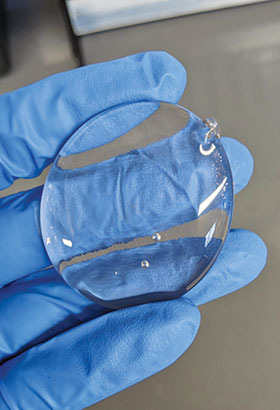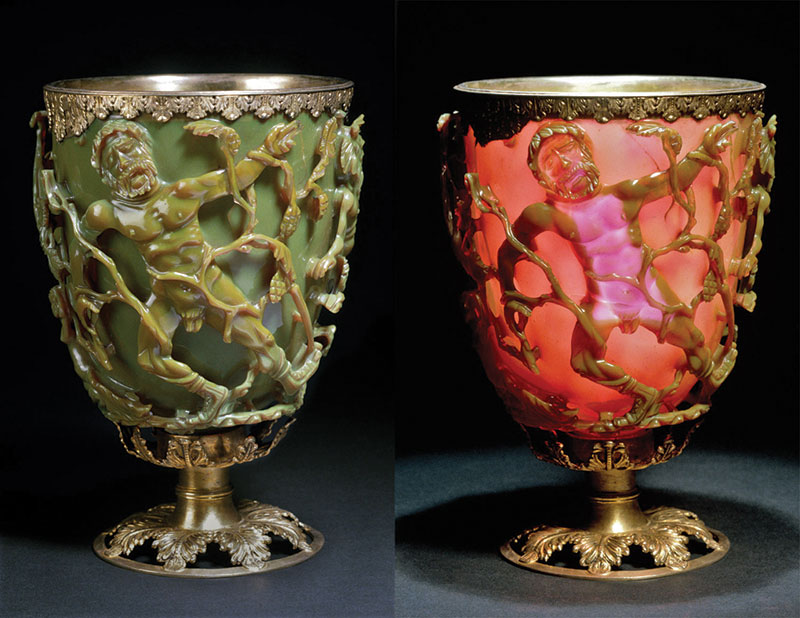Celebrating Glass
Fall
2022
Feature
Celebrating Glass
Brittney Hauke, PhD Candidate in Materials Science and Engineering, Penn State
 It’s the International Year of Glass (IYoG)! The year 2022 was designated as such by the United Nations to promote and celebrate the rich history of glass, its value to humanity, and the possibilities it holds for the future.
It’s the International Year of Glass (IYoG)! The year 2022 was designated as such by the United Nations to promote and celebrate the rich history of glass, its value to humanity, and the possibilities it holds for the future.
Glass has played an important role in human history for millennia. Glass beads dating back more than 4,000 years have been found in what was then Mesopotamia, and glass vessels seem to have emerged in Egypt at around 1,500 BCE. Glass has been and continues to be vital to the advancement of science and technology and the betterment of life for humanity.
Through glass windows we can view the outside world while staying safe from the elements and predators. Glass bottles preserve our food and beverages. Without the development of glass lenses, many readers wouldn’t be able to make out the letters in this article. And humankind would know little about the universe at its largest and smallest scales without the views provided by microscopes and telescopes. Glass has made lasting impacts on society through its use in art and religion as well, in forms such as glass blowing, bead making, stained glass, and glazes.
Glass plays such a critical role in life today that it’s often overlooked. But then why celebrate glass now, in 2022?
“This year’s worldwide celebration of the United Nations–declared International Year of Glass―the only material in UN history so honored―gives exceptional credence to recent proclamations that we have entered the Age of Glass and that glass is the quintessential nanotech material,” says L. David Pye, emeritus dean and professor of glass science at Alfred University and an organizer of the IYoG.
 Some scientists have dubbed the present era the Glass Age because we’re harnessing the unique properties of glass to tackle some of the world’s most imminent problems. Cutting-edge areas of glass research include containing nuclear waste, making safer batteries, biomedical applications ranging from soft tissue regeneration to implants and bone regrowth, electronic and ionically conductive glasses, and more durable glasses and glass ceramics. Glass even helped slow the COVID-19 pandemic: vaccine storage vials couldn’t withstand the storage temperatures required for COVID-19 vaccines, so novel glass ones were created.
Some scientists have dubbed the present era the Glass Age because we’re harnessing the unique properties of glass to tackle some of the world’s most imminent problems. Cutting-edge areas of glass research include containing nuclear waste, making safer batteries, biomedical applications ranging from soft tissue regeneration to implants and bone regrowth, electronic and ionically conductive glasses, and more durable glasses and glass ceramics. Glass even helped slow the COVID-19 pandemic: vaccine storage vials couldn’t withstand the storage temperatures required for COVID-19 vaccines, so novel glass ones were created.
Celebrations marking the IYoG have been happening all year across the world. The opening ceremony at the Palace of Nations in Geneva, Switzerland, in February 2022 included presentations by glass historians, scientists, artists, and engineers. In the United States, the largest celebration was the National Day of Glass Conference, hosted in Washington, DC, in April. The conference featured talks by experts in the North American glass industry, the art community, government agencies, and educational systems.
Although 2022 is coming to a close, it’s not too late to celebrate! Take a class or watch a demonstration of glass blowing or another glass art form; visit a museum to see the colorful history and evolution of glass; or browse the resource list and check out the latest on glass science.
Glass Science Resources
- Physics World (June 2022), https://physicsworld.com/a/celebrating-the-international-year-of-glass-t....
- ACerS Bulletin (2022), https://ceramics.org/publications-resources/the-bulletin-of-the-american....
- Glass: Then and Now—historical journal articles published by the American Ceramic Society, https://ceramics.org/gtan.
- IYoG opening ceremony, https://media.un.org (search “International Year of Glass 2022”).
- National Day of Glass, https://ceramics.org/event/national-day-of-glass.
- GEEX Talks 2022–2023: Expanded Glass Histories, https://geex.glass/programming/geextalks/.
My Glass Research
Glass is a noncrystalline and nonequilibrium material. “Noncrystalline” means that it has a long-range disordered structure, while “nonequilibrium” means that although it appears solid on a short time scale, glass continuously relaxes toward its supercooled liquid state. I study this relaxation because it can change the structure of a glass, and thus its properties. My research focuses on relaxation in glasses that are used for industrial applications. We’re trying to better understand relaxation via experiments and tie our findings back to current theories.
Ancient Nanotechnology
 The Lycurgus Cup is a fourth-century Roman glass chalice that depicts a scene involving King Lycurgus of Thrace. The cup changes colors depending on how it’s viewed: It appears jade green in bright, direct light and when lit from the front. When lit from the inside or back, most of the cup appears blood red, with the king’s body taking on a slightly different shade. This is an example of dichroic glass and was created by adding nanoparticles of silver and gold. Did the Romans know exactly what they were doing, or is the effect due to accidental contamination? Unfortunately, that answer seems to have been lost to time.
The Lycurgus Cup is a fourth-century Roman glass chalice that depicts a scene involving King Lycurgus of Thrace. The cup changes colors depending on how it’s viewed: It appears jade green in bright, direct light and when lit from the front. When lit from the inside or back, most of the cup appears blood red, with the king’s body taking on a slightly different shade. This is an example of dichroic glass and was created by adding nanoparticles of silver and gold. Did the Romans know exactly what they were doing, or is the effect due to accidental contamination? Unfortunately, that answer seems to have been lost to time.
